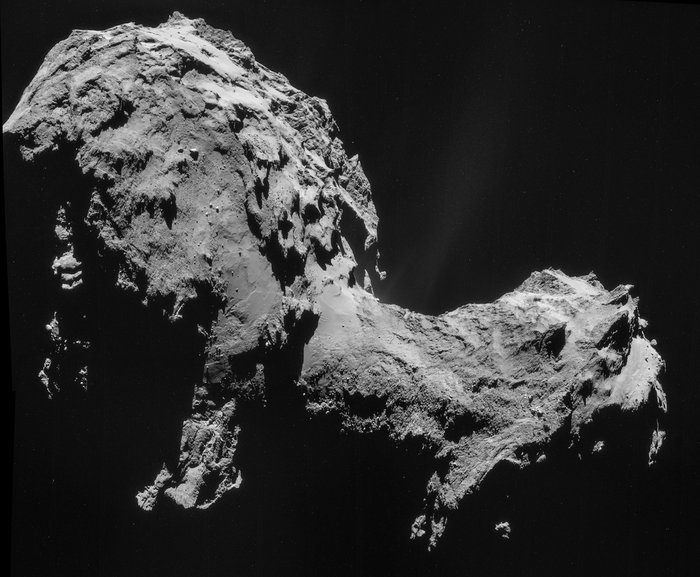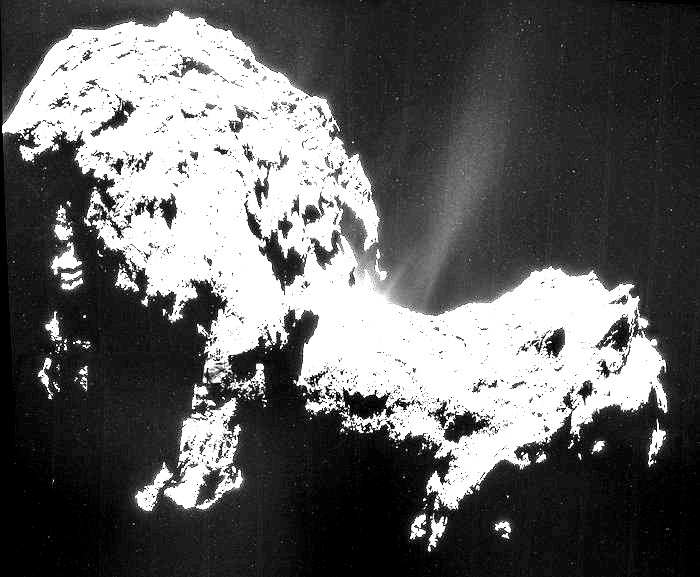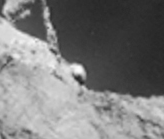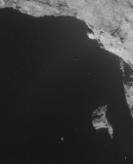It looks like you're using an Ad Blocker.
Please white-list or disable AboveTopSecret.com in your ad-blocking tool.
Thank you.
Some features of ATS will be disabled while you continue to use an ad-blocker.
4
share:
The ESA released a new image of the comet
67P/Churyumov-Gerasimenko (Chury for short) today, and this one seems to have another curious oddity.
In the original image, we can see faint “jets” seeming to erupt from the middle of the comet:

When the image is contrast enhanced, the source of the jets seems to be coming from the rocky surface itself, rather than from a well defined “vent” source:

The contrast enhanced image seems to show a curious phenomena… the rocks are glowing. Taking a zoomed in portion of the image and setting it to an animation of contrast, we can see a glowing halo emerge from the boulder in the center of frame:

This is not an artifact. The boulder in the image is surrounded by a faint glow. As you can see from the above image, this glow does not appear on other rocks that are contrast enhanced. It only appears on the rocks that seem to be the source of the “jets.” Of course, these aren’t really “jets” at all, they are an electrified plasma discharge into silicate rocks.
In a previous article, I commented on the presence of an anomalous glowing disk that appeared in a recent image of Chury that some people had claimed was a UFO. In that article I demonstrated the glowing disk was most likely a plasma discharge. As the comet gets ever closer to the Sun, we will begin to see brighter and more numerous discharges blasting away the comet’s surface. The red dot is the location of the “UFO” in relation to the contrast enhanced “jets":

There is no ice on comet Chury. There are no jets of sublimating water on comet Chury. There is no ice hidden beneath the surface of comet Chury. The processes taking place on the comet are entirely electrically driven.
To learn more about the electrical nature of comets, watch this:
Previous related articles I've done on this comet:
In the original image, we can see faint “jets” seeming to erupt from the middle of the comet:

When the image is contrast enhanced, the source of the jets seems to be coming from the rocky surface itself, rather than from a well defined “vent” source:

The contrast enhanced image seems to show a curious phenomena… the rocks are glowing. Taking a zoomed in portion of the image and setting it to an animation of contrast, we can see a glowing halo emerge from the boulder in the center of frame:

This is not an artifact. The boulder in the image is surrounded by a faint glow. As you can see from the above image, this glow does not appear on other rocks that are contrast enhanced. It only appears on the rocks that seem to be the source of the “jets.” Of course, these aren’t really “jets” at all, they are an electrified plasma discharge into silicate rocks.
In a previous article, I commented on the presence of an anomalous glowing disk that appeared in a recent image of Chury that some people had claimed was a UFO. In that article I demonstrated the glowing disk was most likely a plasma discharge. As the comet gets ever closer to the Sun, we will begin to see brighter and more numerous discharges blasting away the comet’s surface. The red dot is the location of the “UFO” in relation to the contrast enhanced “jets":

There is no ice on comet Chury. There are no jets of sublimating water on comet Chury. There is no ice hidden beneath the surface of comet Chury. The processes taking place on the comet are entirely electrically driven.
To learn more about the electrical nature of comets, watch this:
Previous related articles I've done on this comet:
The UFO Discovered On Comet Chury By The Rosetta Probe
The “Surprisingly” Dark Comet Chury
New Discovery: Dreadnoughtus, The Impossibly Huge Dinosaur
The Recurring Odd Shape Of Comets
Predictions: Landing On Comet 67P
edit on 9/19/2014 by AnarchoCapitalist because: (no reason given)
It is due to jpeg compression artifacts, and they show up around other rocks at different
contrast stretch levels. Use an enlarged portion of the original NAVCAM frame, there's a lot less jpeg artifacts there, and the glowing is practically abscent.

Lots of unsupported statements there, as usual. I would have hoped for something more solid from you.
contrast stretch levels. Use an enlarged portion of the original NAVCAM frame, there's a lot less jpeg artifacts there, and the glowing is practically abscent.

originally posted by: AnarchoCapitalist
There is no ice on comet Chury. There are no jets of sublimating water on comet Chury. There is no ice hidden beneath the surface of comet Chury. The processes taking place on the comet are entirely electrically driven.
Lots of unsupported statements there, as usual. I would have hoped for something more solid from you.
edit on 19-9-2014 by wildespace because:
(no reason given)
a reply to: wildespace
The image you linked is for an entirely different picture!
Anyone can see with their own two eyes that the rest of the rocks do not emit a glow in the animation. It purely surrounds the boulder that is the apparent jet source. You can even see the collimated jet extending away from the boulder as the contrast is enhanced. That is not an artifact.
ANYONE can duplicate the image by adjusting the contrast levels of the original NAVCAM image if they download it for themselves.
This is the original image that I used to make the animation.
I'll do it to your image too, hold on.
It's still glowing:

If you have a different source for that same image, I'm all ears.
The image you linked is for an entirely different picture!
Anyone can see with their own two eyes that the rest of the rocks do not emit a glow in the animation. It purely surrounds the boulder that is the apparent jet source. You can even see the collimated jet extending away from the boulder as the contrast is enhanced. That is not an artifact.
ANYONE can duplicate the image by adjusting the contrast levels of the original NAVCAM image if they download it for themselves.
This is the original image that I used to make the animation.
I'll do it to your image too, hold on.
It's still glowing:

If you have a different source for that same image, I'm all ears.
edit on 9/19/2014 by AnarchoCapitalist because: (no reason given)
a reply to: AnarchoCapitalist
That image you used is an enlarged mosaic of the four NAVCAM images stitched together. That enlarged image has jpeg artifacts around the rock (you can see them as the slightly brighter pixels). Have a look here for the four individual NAVCAM images. It's always better to use original images rather than a second-generation processed image that may have more additional artifacts.
There are two of these NAVCAM images that show that rock; I linked to one of them. Here's the other one.
Regarding the large and enlarged mosaic that you used as your source, the blog says: "The full image has then been lightly contrast enhanced to bring out the activity without increasing the background noise too much." This contrast enhancement might have made those jpeg artifacts around the rock more pronounced, leading to an even more pronounced effect when you increased the contrast further.
That image you used is an enlarged mosaic of the four NAVCAM images stitched together. That enlarged image has jpeg artifacts around the rock (you can see them as the slightly brighter pixels). Have a look here for the four individual NAVCAM images. It's always better to use original images rather than a second-generation processed image that may have more additional artifacts.
There are two of these NAVCAM images that show that rock; I linked to one of them. Here's the other one.
Regarding the large and enlarged mosaic that you used as your source, the blog says: "The full image has then been lightly contrast enhanced to bring out the activity without increasing the background noise too much." This contrast enhancement might have made those jpeg artifacts around the rock more pronounced, leading to an even more pronounced effect when you increased the contrast further.
edit on 19-9-2014 by wildespace because:
(no reason given)
a reply to: AnarchoCapitalist
The geometry of this body is telling a story the conventional comet model can't explain. Seeing "mass discharges" from the deeply eroded "waist" area, totally violates the sub-surface ice hypothesis.
I believe this is just the beginning of a truly groundbreaking piece of science/astronomy. It should really become clear as this body rounds the Sun.
The geometry of this body is telling a story the conventional comet model can't explain. Seeing "mass discharges" from the deeply eroded "waist" area, totally violates the sub-surface ice hypothesis.
I believe this is just the beginning of a truly groundbreaking piece of science/astronomy. It should really become clear as this body rounds the Sun.
originally posted by: InverseLookingGlass
a reply to: AnarchoCapitalist
The geometry of this body is telling a story the conventional comet model can't explain. Seeing "mass discharges" from the deeply eroded "waist" area, totally violates the sub-surface ice hypothesis.
Only if you assume that the ice distribution must have been perfectly homogenous to start with. I see no reason to assume that. Actually it fits what I expected.
originally posted by: AnarchoCapitalist
The contrast enhanced image seems to show a curious phenomena… the rocks are glowing.
Oh my god!!!!!!!! Your head is glowing!!!!!!!

There we go, conclusive proof that your head is an electric comet!!!!! This is irrefutable! Your head contains no visible surface vents, therefore it contains no ice, therefore the only possible explanation is that it is a plasma glow caused by electrical discharge.
OK
Here's the C frame, which shows the extended jet:
blogs.esa.int...

The glow is clear because it's the source of the "jet."
The "jet" is not emerging from a specific crack in the ground, it is emerging from the area all around the boulder.
It doesn't matter what image you chose to use, the glow is going to be there because the "jet" is there.
We can look at the surrounding rocks and see they are not glowing. They have sharply defined edges no matter what the contrast and brightness settings are adjusted to. This is not true for the area around the boulder that fuzzes up because of the discharge that's surrounding it.
Here's the C frame, which shows the extended jet:
blogs.esa.int...

The glow is clear because it's the source of the "jet."
The "jet" is not emerging from a specific crack in the ground, it is emerging from the area all around the boulder.
It doesn't matter what image you chose to use, the glow is going to be there because the "jet" is there.
We can look at the surrounding rocks and see they are not glowing. They have sharply defined edges no matter what the contrast and brightness settings are adjusted to. This is not true for the area around the boulder that fuzzes up because of the discharge that's surrounding it.
edit on 9/19/2014 by AnarchoCapitalist because: (no reason given)
originally posted by: InverseLookingGlass
a reply to: AnarchoCapitalist
The geometry of this body is telling a story the conventional comet model can't explain. Seeing "mass discharges" from the deeply eroded "waist" area, totally violates the sub-surface ice hypothesis.
I believe this is just the beginning of a truly groundbreaking piece of science/astronomy. It should really become clear as this body rounds the Sun.
Yeah there can be no doubt this is an electrical phenomena.
The lack of distinct "vents."
The discharges from the waist of the comet.
The pitch black surface.
The recurring twin lobes of comets.
The lack of any observable ice.
The x-ray emissions.
The collimated jets that violate the laws of neutral gas behavior in a vacuum.
The mismatch of hydrogen to OH when compared to theories of photodissociation.
The finely divided dust, along with gravel that is far too big to be attributed to sublimating ice.
The observed presence of crystallized minerals that could only form in the presence of LIQUID water.
The observed presence of crystallized minerals that could only form in intense heat.
CMEs are routinely observed when comets get too close to the Sun.
Comet tails disconnecting from the comet nucleus.
The unexplained confined spherical coma that can extend for millions of miles.
The unexplained presence of braided collimated tails that can extend for millions of miles.
The unexplained brightening of comets at distances too far from the Sun to be explained by sublimating ice.
Hell, the list is endless.
I might be going a bit arken here( no disrespect arken) but it looks like a dog
originally posted by: wildespace
a reply to: AnarchoCapitalist
A few of the vents have been identified.
No they haven't.
Show me the image.
I don't see an image of a vent source.
I see a picture of a crater doing nothing.
edit on 9/19/2014 by AnarchoCapitalist because: (no reason given)
a reply to: AnarchoCapitalist
Why don't we wait until Philae lands on the comet? If it lands, then I guess the electrical comet issue would have been disproved, if the landing goes haywire, nothing would have been proved or not, depending on what went wrong, but with Rosetta being so close to the comet, don't you think it would have been zapped by the 'electric comet' already? Looking at the images and the data of the comet, it is becoming even more clear to me that the 'dirty snowball' theory is correct, but the proof will be in the (successful) landing and the data Philae gathers. (and seeing that Rosetta is an ESA project, nobody can blame NASA from hiding stuff). heck, just writing that last bit freaked me out!!!!!!
Why would the scientific community at large try to hide the EU hypothesis, if it is true? don't they know there will be a couple of Nobel prices if they can prove that all Newtonian and relativistic physics are wrong? I mean, every scientist I know, would sell their souls for winning a Nobel price....
Why don't we wait until Philae lands on the comet? If it lands, then I guess the electrical comet issue would have been disproved, if the landing goes haywire, nothing would have been proved or not, depending on what went wrong, but with Rosetta being so close to the comet, don't you think it would have been zapped by the 'electric comet' already? Looking at the images and the data of the comet, it is becoming even more clear to me that the 'dirty snowball' theory is correct, but the proof will be in the (successful) landing and the data Philae gathers. (and seeing that Rosetta is an ESA project, nobody can blame NASA from hiding stuff). heck, just writing that last bit freaked me out!!!!!!
Why would the scientific community at large try to hide the EU hypothesis, if it is true? don't they know there will be a couple of Nobel prices if they can prove that all Newtonian and relativistic physics are wrong? I mean, every scientist I know, would sell their souls for winning a Nobel price....
a reply to: AnarchoCapitalist
So your scientific method for this latest bit of evidence is 'turning up the contrast'?
Wow.
So your scientific method for this latest bit of evidence is 'turning up the contrast'?
Wow.
a reply to: AnarchoCapitalist
Yeah you also predicted that...
And that's grossly inaccurate!
So have you considered the possibility that these jets, if that's what they are, are coming from vents on the far side of the comet, unseen by Roseta.
Yeah you also predicted that...
1. The surface of the comet will be solid rock.
And that's grossly inaccurate!
So have you considered the possibility that these jets, if that's what they are, are coming from vents on the far side of the comet, unseen by Roseta.
Yet the standard model explains everything witnessed so far. EU model has no answer for the mass of Churny, which is why you proclaim the data is
wrong and there is an EU explanation somewhere to make massive comets appear to have much less mass .. we just have to trust you.
It's funny how you twist data (turn up the contrast) to force the data to fit your beliefs .. and when you can't twist you you simply claim the data is wrong (the mass readings can't be right because Churny is 10x more massive says the EU model).
It's funny how you twist data (turn up the contrast) to force the data to fit your beliefs .. and when you can't twist you you simply claim the data is wrong (the mass readings can't be right because Churny is 10x more massive says the EU model).
Other analyses suggest the comet's surface is largely water-ice covered with a thin dust layer.
www.bbc.com...
BOOM. Bye.
new topics
-
Predicting The Future: The Satanic Temple v. Florida
Conspiracies in Religions: 7 minutes ago -
WF Killer Patents & Secret Science Vol. 1 | Free Energy & Anti-Gravity Cover-Ups
General Conspiracies: 2 hours ago -
Hurt my hip; should I go see a Doctor
General Chit Chat: 3 hours ago -
Israel attacking Iran again.
Middle East Issues: 4 hours ago -
Michigan school district cancels lesson on gender identity and pronouns after backlash
Education and Media: 4 hours ago -
When an Angel gets his or her wings
Religion, Faith, And Theology: 5 hours ago -
Comparing the theology of Paul and Hebrews
Religion, Faith, And Theology: 5 hours ago -
Pentagon acknowledges secret UFO project, the Kona Blue program | Vargas Reports
Aliens and UFOs: 6 hours ago -
Boston Dynamics say Farewell to Atlas
Science & Technology: 7 hours ago -
I hate dreaming
Rant: 7 hours ago
top topics
-
The Democrats Take Control the House - Look what happened while you were sleeping
US Political Madness: 10 hours ago, 18 flags -
In an Historic First, In N Out Burger Permanently Closes a Location
Mainstream News: 12 hours ago, 16 flags -
A man of the people
Medical Issues & Conspiracies: 17 hours ago, 11 flags -
Man sets himself on fire outside Donald Trump trial
Mainstream News: 9 hours ago, 9 flags -
Biden says little kids flip him the bird all the time.
Politicians & People: 9 hours ago, 9 flags -
Pentagon acknowledges secret UFO project, the Kona Blue program | Vargas Reports
Aliens and UFOs: 6 hours ago, 6 flags -
Michigan school district cancels lesson on gender identity and pronouns after backlash
Education and Media: 4 hours ago, 6 flags -
WF Killer Patents & Secret Science Vol. 1 | Free Energy & Anti-Gravity Cover-Ups
General Conspiracies: 2 hours ago, 6 flags -
Israel attacking Iran again.
Middle East Issues: 4 hours ago, 5 flags -
Boston Dynamics say Farewell to Atlas
Science & Technology: 7 hours ago, 4 flags
active topics
-
The New, New ATS Members Photos thread. Part 3.
Members • 1653 • : zosimov -
Predicting The Future: The Satanic Temple v. Florida
Conspiracies in Religions • 0 • : Degradation33 -
A man of the people
Medical Issues & Conspiracies • 15 • : PrivateAngel -
Israel attacking Iran again.
Middle East Issues • 27 • : KrustyKrab -
I hate dreaming
Rant • 7 • : TheMichiganSwampBuck -
MULTIPLE SKYMASTER MESSAGES GOING OUT
World War Three • 53 • : Zaphod58 -
Michigan school district cancels lesson on gender identity and pronouns after backlash
Education and Media • 8 • : TheMichiganSwampBuck -
I Guess Cloud Seeding Works
Fragile Earth • 29 • : Justoneman -
Man sets himself on fire outside Donald Trump trial
Mainstream News • 40 • : Vermilion -
When an Angel gets his or her wings
Religion, Faith, And Theology • 5 • : randomuser2034
4
